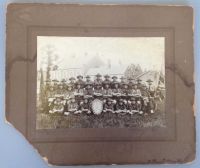At Surrey History Centre, we are often asked about best practice in handling, storing and preserving records at home to keep them in good condition. On this page, we offer practical advice on the care of photographs, probably the most commonly collected memorabilia. Virtually every household owns a collection of photographs – perhaps as part of a family history archive - that will be stored loosely or in albums. As can be seen from the sorry condition of many old photographs, they are extremely delicate objects, vulnerable to rough handling, and as such should be treated with respect!
Handling photographs
 Careless handling of photographs is a major cause of harm: oil and perspiration from fingerprints can weaken and discolour the photograph, whilst dirt can scratch delicate surfaces. Try to handle photographs or negatives with clean hands, or wear clean, lint-free cotton gloves. Avoid touching the emulsion side of a photograph; instead hold the edge or use a sheet of paper or the photographic mount to act as a carrier. This image of a water-damaged photograph shows that a mount, however discoloured or shabby, should never be removed as it provides additional protection.
Careless handling of photographs is a major cause of harm: oil and perspiration from fingerprints can weaken and discolour the photograph, whilst dirt can scratch delicate surfaces. Try to handle photographs or negatives with clean hands, or wear clean, lint-free cotton gloves. Avoid touching the emulsion side of a photograph; instead hold the edge or use a sheet of paper or the photographic mount to act as a carrier. This image of a water-damaged photograph shows that a mount, however discoloured or shabby, should never be removed as it provides additional protection.
Captioning a photograph may be important for posterity but avoid marking it with ink; instead write carefully on the reverse with a 2B pencil. Keep your photographs in a clean environment and protect them from contact with food and drink! To reduce frequent handling of fragile originals, scan or take digital photographs, but avoid photocopying.
Storage conditions
Photographs have a complex physical and chemical structure requiring special storage and packaging in order to maximise their life. Their inherent instability, often due to poor original processing, causes deterioration, and exposure to light, particularly sunlight, causes fading. High temperatures and moisture will accelerate deterioration, promoting the growth of mould and mildew, which can affect surfaces, break down layers and cause adhesion. Ideally photographs should be stored in stable conditions with a relative humidity of 30-40%, and a temperature of 8-15° Celsius.
Correct packaging
 Only use packaging materials that have specifically been developed and tested for photographic storage. Look for acid-free boxes, wherever possible, and select suitable packaging for different media:
Only use packaging materials that have specifically been developed and tested for photographic storage. Look for acid-free boxes, wherever possible, and select suitable packaging for different media:
- Paper prints and film negatives. Use Melinex (polyester) sleeves for frequently viewed items and where climatic storage conditions are good. If not, use sulphur-free paper envelopes. Place items with damaged emulsions in four-flap paper enclosures. Large prints should be wrapped individually in sulphur-free paper.
- Cased photographs (daguerreotypes and ambrotypes) should not be removed from their frames. Wrap in sulphur-free paper and place in a paper envelope.
- Glass plate negatives should be placed in paper envelopes. Use four-flap paper enclosures for broken plates and those with damaged emulsions. Store vertically and add cushioning board at every fifth plate.
- Slides should be stored vertically in specially designed boxes or in polyester slide storage pages for ring binders or suspension files.
- Albums. Wrap early albums in sulphur-free paper. Remove photographs from modern albums and place in archival albums.
Avoid inferior-quality storage materials, such as pvc, self-adhesive albums and tapes, paper clips and rubber bands, as these cause deterioration.
The adoption of good practices to care for and preserve your photographs will ensure that they continue to provide a valuable historic record for years to come. For further assistance and advice, please contact our conservator, telephone 01483 518737 or email shs@surreycc.gov.uk

